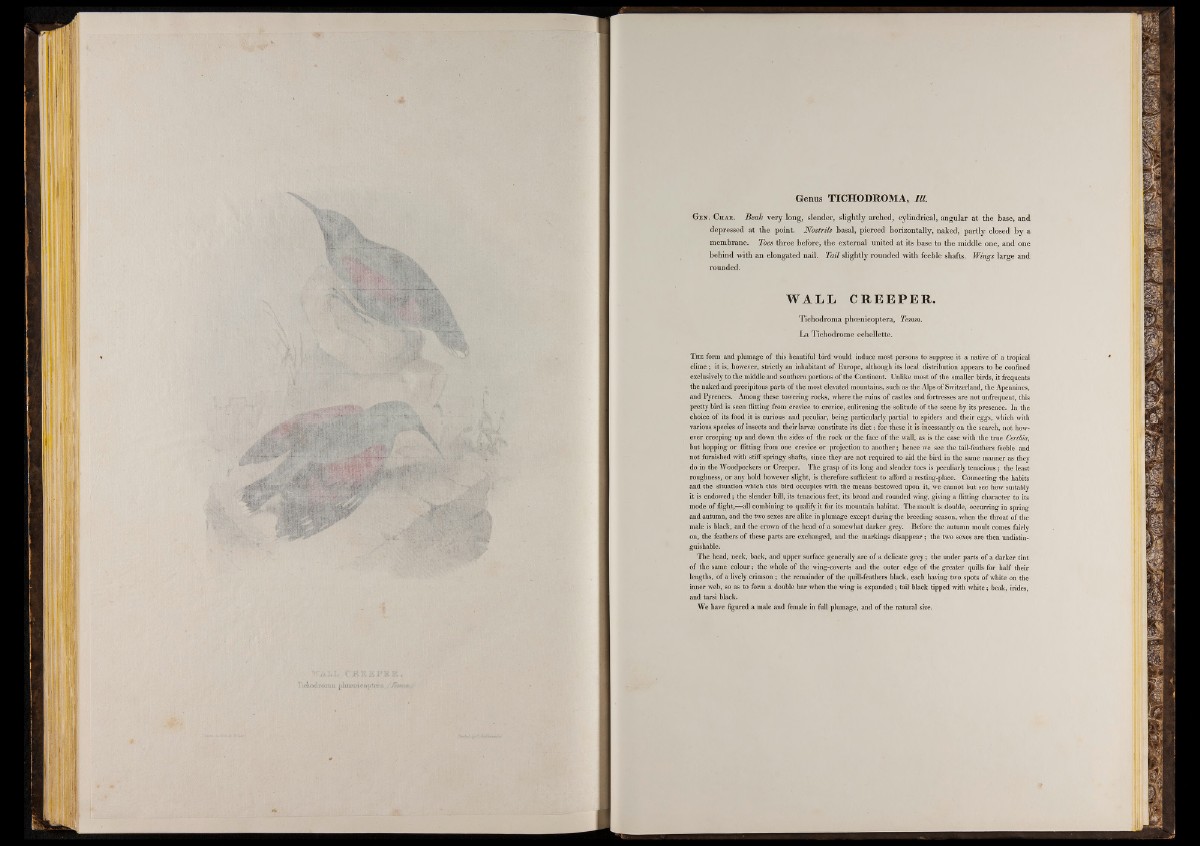
Genus TICHODROMA, III
Gen. C h a r. B ea k very long, slender, slightly arched, cylindrical, angular a t the base, and
depressed a t th e point. N o strils basal, pierced horizontally, naked, p artly closed b y a
membrane. Toes three before, the external united a t its base to the middle one, and one
behind with an elongated nail. T a il slightly rounded with feeble shafts. Wings large and
rounded.
WA L L CR E E P ER .
T ic h o d rom a phoenicoptera, Temm.
L a T ich o d rom e echellette.
The form and plumage of this beautiful bird would induce most persons to suppose it a native o f a tropical
clime; it is, however, strictly an inhabitant of Europe, although its local distribution appears to be confined
exclusively to the middle and southern portions o f the Continent. Unlike most of the smaller birds, it frequents
the naked and precipitous parts o f the most elevated mountains, such as the Alps of Switzerland, the Apennines,
and Pyrenees. Among these towering rocks, where the ruins of castles and fortresses are not unfrequent, this
pretty bird is seen flitting from crevice to crevice, enlivening the solitude o f the scene by its presence. In the
choice of its food it is curious and peculiar, being particularly partial to spiders and their eggs, which with
various species o f insects and their larvae constitute its diet: for these it is incessantly on the search, not however
creeping up and down the sides of the rock or the face of the wall, as is the case with the true Certhia,
but hopping or flitting from one crevice or projection to another; hence we see the tail-feathers feeble and
not furnished with stiff springy shafts, since they are not required to aid the bird in the same manner as they
do in the Woodpeckers or Creeper. The grasp of its long and slender toes is peculiarly tenacious; the least
roughness, or any hold however slight, is therefore sufficient to afford a resting-place. Connecting the habits
and the situation which this bird occupies with the means bestowed upon it, we cannot but see how suitably
it is endowed; the slender bill, its tenacious feet, its broad and rounded wing, giving a flitting character to its
mode of flight,—all combining to qualify it for its mountain habitat. The moult is double, occurring in spring
and autumn, and the two sexes are alike in plumage except during the breeding season, when the throat of the
male is black, and the crown of the head of a somewhat darker grey. Before the autumn moult comes fairly
on, the feathers o f these parts are exchanged, and the markings disappear; the two sexes are then undistin-
guishable.
The head, neck, back, and upper surface generally are of a delicate grey; the under parts of a darker tint
of the same colour; the whole of the wing-coverts and the outer edge of the greater quills for half their
lengths, o f a lively crimson; the remainder of the quill-feathers black, each having two spots of white on the
inner web, so as to form a double bar when the wing is expanded; tail black tipped with white; beak, irides,
and tarsi black.
We have figured a male and female in full plumage, and of the natural size.